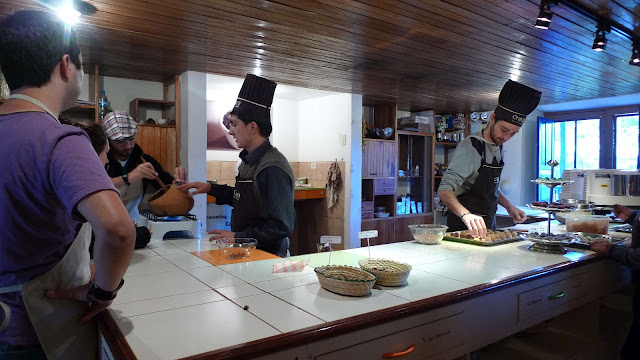In the guide book I was using, I read about a coca museum. It sounded very interesting. Supposedly it had a great exhibit on the coca plant and its importance to the Peruvian culture and the bastardization of the plant as cocaine. It is supposed to be in San Blas, which was right behind our hotel somewhere(which also meant uphill again). However when we looked at the map we got a little confused and we went the opposite direction. Good thing, because instead we found the cacao museum! Qué Suerte!
Theobroma Cacao: Theobroma coming from the Greek and meaning food of the Gods and Kakaw which was the Maya word for the bean.
Cacao contains Dopamine, Serotonin and Theobromine which are all mood enhancers. It also houses good amounts of magnesium, a mineral in which most Americans are deficient.
The museum had some great information on where chocolate came from and
how it reached Europe becoming a good demanded world wide.
Cacao beans grow in pods on trees. They are surrounded by a white pulp which is removed and can be eaten. The beans are then either piled up or put on trays and covered in banana leaves and left to ferment. After fermentation they are spread out and left to dry in the sun. After that it is off to exportation!
At the museum you can roast your own beans and make truffles. You can
also buy roasted cacao bean shells to be used for tea.
I did and it
is delicious.
The way the Maya, Aztec and Inca drank cacao was by grinding the beans with stones. Once the beans formed a paste, they would mix it with spices and water. Then they would pour the mixture, back and forth, from one cup to another to create a froth.
Interesting to you perhaps, is the fact that the Inca even had access to cacao. Cacao is from Mexico; it started its rise to popularity in the Yucatan Peninsula.
Archeologists may have found proof that cacao existed in Honduras as far back as 1100 AD. They found pottery with traces of theobromine and caffeine in them and speculate they were vessels used for cacao consumption.
Cacao was integral to Mayan and later Aztec culture. It was not native to Peru. Which means that the Inca imported the cacao from the Yucatan or possibly even Honduras. Can you imagine that trip? Neither can Google maps. I tried to see how long it would take to walk from Cuzco to Tegucigalpa and Google couldn't calculate it. Crazy!
Cacao was valuable enough to both the Maya, Inca and Aztec to be used as currency. You could buy lots of things with it including prostitutes.
Some interesting differences between the Inca and Maya:
*The Maya never had a central capital nor leader. Each city ruled itself. The Inca capital was Cuzco and it had many emperors in succession. Inca is actually the name for the ruling class of the Quechua, which were the people.
*The Maya had a written language, the Inca did not.
*The Inca Empire lasted only a hundred years ending with the arrival and subsequent take-over of the Spanish. The Maya Civilization lasted thousands of years and sort of just slipped out of being after the arrival of the Spanish. Maya descendants still exist and still speak the original language.






No comments:
Post a Comment